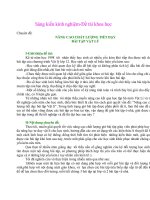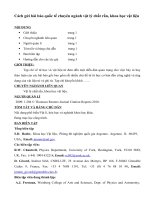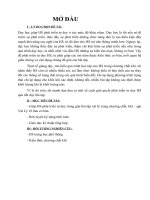Bài tập Vật lý chất rắn (5)
Bạn đang xem bản rút gọn của tài liệu. Xem và tải ngay bản đầy đủ của tài liệu tại đây (286.24 KB, 8 trang )
EE145 Spring 2002 Homework 7 Solution Prof. Ali Shakouri
Second Edition ( 2001 McGraw-Hill)
Chapter 7
7.1 Relative permittivity and polarizability
a. Show that the local field is given by
E
loc
= E
ε
r
+ 2
3
Local field
b. Amorphous selenium (a-Se) is a high resistivity semiconductor that has a density of approximately
4.3 g cm
-3
and an atomic number and mass of 34 and 78.96 g/mol respectively. Its relative
permittivity at 1 kHz has been measured to be 6.7. Calculate the relative magnitude of the local
field in a-Se. Calculate the polarizability per Se atom in the structure. What type of polarization is
this? How will
ε
r
depend on the frequency?
c. If the electronic polarizability of an isolated atom is given by
α
e
≈ 4
πε
o
r
o
3
where r
o
is the radius of the atom, then calculate the electronic polarizability of an isolated Se
atom, which has r
0
= 0.12 nm, and compare your result with that for an atom in a-Se. Why is there
a difference?
Solution
a The polarization, P, is given by:
P =
ε ε
−1
[]()
E
o r
where
E is the electric field.
The local field E
loc
is given by:
E
loc
= E +
P
3
ε
o
Substitute for P:
E
loc
= E +
ε
o
ε
r
−1
[]()
E
3
ε
o
= 1 +
ε
r
−1
(
)
3
E =
3 +
ε
r
− 1
3
E
∴
E
loc
=
ε
r
+ 2
3
E
b The relative magnitude of the local field refers to the local field compared to the applied field,
i.e.:
E
loc
/ E. Therefore, with
ε
r
= 6.7:
E
loc
E
=
ε
r
+ 2
3
=
6.7
+
2
3
=
2.9
If D is the density then the concentration of Se atoms N is
7.1
EE145 Spring 2002 Homework 7 Solution Prof. Ali Shakouri
N =
DN
A
M
at
=
4.3 ×10
3
kg/m
3
()
6.022
×
10
23
mol
−
1
(
)
78.96 ×10
−3
kg/mol
()
= 3.279 × 10
28
m
-3
The Clausius-Mossotti equation relates the relative permittivity to the electronic polarizability,
α
e
:
ε
r
−1
ε
r
+ 2
=
N
3
ε
o
α
e
∴
α
e
=
3
ε
o
ε
r
− 1
()
N
ε
r
+ 2
()
=
3 8.854
×
10
−
12
F/m
(
)
6.7
−
1
(
)
3.279 ×10
28
m
−3
()
6.7 + 2()
∴
α
e
= 5.31 × 10
-40
F m
2
This would be a type of electronic polarization, as Se is a covalent solid.
ε
r
is flat up to optical
frequencies.
c The Se atom has a radius of about r
o
= 0.12 nm. Substituting into the given equation:
α
e
′ ≈ 4
πε
o
r
o
3
= 4
π
(8.854 × 10
-9
F/m)(0.12 × 10
-9
m)
3
∴
α
e
′ ≈ 1.92 × 10
-40
F m
2
Comparing this value and our previous value:
α
e
′
α
e
=
5.30 ×10
−40
F m
2
1.92 ×10
−40
F m
2
= 2.76
The observed polarizability per Se atom in the solid is 2.8 times greater than the polarizability of
the isolated Se atom. In the solid, valence electrons are involved in bonding and these electrons
contribute to electronic bond polarization (the field can displace these electrons).
7.2 Relative permittivity, bond strength, bandgap and refractive index
Diamond, silicon, and germanium are covalent solids with the same crystal structure. Their
relative permittivities are shown in Table 7Q2-1.
a. Explain why
ε
r
increases from diamond to germanium.
b. Calculate the polarizability per atom in each crystal and then plot polarizability against the
elastic modulus Y (Young's modulus). Should there be a correlation?
c. Plot the polarizability from part b against the bandgap energy, E
g
. Is there a relationship?
d. Show that the refractive index n is √
ε
r
. When does this relationship hold and when does it fail?
e. Would your conclusions apply to ionic crystals such as NaCl?
Table 7Q2-1 Properties of diamond, Si, and Ge
ε
r
M
at
Density
(g cm
-3
)
α
e
Y
(GPa)
E
g
(eV)
n
Diamon
d
5.8 12 3.52 827 5.5 2.42
Si 11.9 28.09 2.33 190 1.12 3.45
Ge 16 72.61 5.32 75.8 0.67 4.09
7.2
EE145 Spring 2002 Homework 7 Solution Prof. Ali Shakouri
Solution
a In diamond, Si, and Ge, the polarization mechanism is electronic (bond). There are two factors
that increase the polarization. First is the number of electrons available for displacement and the ease
with which the field can displace the electrons. The number of electrons in the core shells increases
from diamond to Ge. Secondly, and most importantly, the bond strength per atom decreases from
diamond to Ge, making it easier for valence electrons in the bonds to be displaced.
b For diamond, atomic concentration N is:
N =
DN
A
M
at
=
3.52 ×10
3
kg/m
3
()
6.022
×
10
23
mol
−
1
(
)
12 ×10
−3
kg/mol
()
= 1.766 × 10
29
m
-3
The polarizability can then be found from the Clausius-Mossotti equation:
ε
r
−1
ε
r
+ 2
=
N
3
ε
o
α
e
∴
α
e
=
3
ε
o
ε
r
− 1
()
N
ε
r
+ 2
()
=
3 8.854
×
10
−
12
F/m
(
)
5.8
−
1
(
)
1.766 ×10
29
m
−3
()
5.8 + 2()
∴
α
e
= 9.256 × 10
-41
F m
2
The polarizability for Si and Ge can be found similarly, and are summarized in Table 7Q2-2:
Table 7Q2-2 Polarizability values for diamond, Si and Ge
N (m
-3
)
α
e
(F m
2
)
Diamond
1.766 × 10
29
m
-3
9.256 × 10
-41
F m
2
Si
4.995 × 10
28
m
-3
4.170 × 10
-40
F m
2
Ge
4.412 × 10
28
m
-3
5.017 × 10
-40
F m
2
6.00 × 10
-40
5.00 × 10
-40
4.00 × 10
-40
3.00 × 10
-40
2.00 × 10
-40
1.00 × 10
-40
0
0 200 400 600 800 1000
Young's modulus (GPa)
α
= 5.311 × 10
-40
- (5.327 × 10
-43
)Y
Correlation coefficient = 0.9969
Figure 7Q2-1 Plot of polarizability per atom versus Young’s modulus.
7.3
EE145 Spring 2002 Homework 7 Solution Prof. Ali Shakouri
As the polarization mechanism in these crystals is due to electronic bond polarization, the
displacement of electrons in the covalent bonds depends on the flexibility or elasticity of these bonds
and hence also depends on the elastic modulus.
c
6.00 × 10
-40
α
= 5.325 × 10
-40
- (8.0435 × 10
-41
)E
g
Correlation coefficient = 0.9873
Bandgap, E
g
(eV)
5.00 × 10
-40
4.00 × 10
-40
3.00 × 10
-40
2.00 × 10
-40
1.00 × 10
-40
0
0123456
Figure 7Q2-2 Plot of polarizability versus bandgap energy.
There indeed seems to be a linear relationship between polarizability and bandgap energy.
d To facilitate this proof, we can plot a graph of refractive index, n, versus relative permittivity,
ε
r
.
5
2
41020
Log-log plot: Power law
Relative permittivity,
ε
r
Figure 7Q2-3 Logarithmic plot of refractive index versus relative permittivity.
The log-log plot exhibits a straight line through the three points. The best fit line is n = A
ε
r
x
(Correlation coefficient is 0.9987) where x = 0.513 ≈ 1/2 and A = exp(−0.02070) ≈ 1. Thus n = √(
ε
r
).
The refractive index n is an optical property that represents the speed of a light wave, or an
electromagnetic wave, through the material (v = c/n). The light wave is a high frequency
electromagnetic wave where the frequency is of the order of 10
14
− 10
15
Hz (ƒ
optical
). n and
polarizability (or
ε
r
) will be related if the polarization can follow the field oscillations at this frequency
(ƒ
optical
). This will be the case in electronic polarization because electrons are light and rapidly respond
7.4
EE145 Spring 2002 Homework 7 Solution Prof. Ali Shakouri
to the fast oscillations of the field. The relationship between n and
ε
r
will not hold if we take
ε
r
at a low
frequency (<< ƒ
optical
) where other slow polarization contributions (such as ionic polarization, dipolar
polarization, interfacial polarization) also contribute to
ε
r
.
e n =
ε
r
would apply to ionic crystals if
ε
r
is taken at the corresponding optical frequency rather
than at frequencies below ƒ
optical
. Tabulated data for ionic crystals typically quote
ε
r
that includes ionic
polarization and hence this data does NOT conform to
n
=
ε
r
.
Chapter 8
8.1 Inductance of a long solenoid
Consider the very long (ideally infinitely long) solenoid shown in Figure 8Q1-1. If r is the radius of
the core and
l
is the length of the solenoid, then
l
>> r. The total number of turns is N and the
number of turns per unit length is n = N/
l
. The current through the coil wires is I. Apply Ampere's
law around C, which is the rectangular circuit PQRS, and show that
B ≈
µ
o
µ
r
nI
Further, show that the inductance is
L ≈
µ
o
µ
r
n
2
V
core
Inductance of long solenoid
where V
core
is the volume of the core. How would you increase the inductance of a long solenoid?
What is the approximate inductance of an air-cored solenoid with a diameter of 1 cm, length of
20 cm, and 500 turns? What is the magnetic field inside the solenoid and the energy stored in the
whole solenoid when the current is 1 A? What happens to these values if the core medium has a
relative permeability
µ
r
of 600?
B
P
Q
RS
I
C
n = Turns per unit length
r
µ
r
Figure 8Q1-1
Solution
We use Ampere's law in Equation 8.15 (in the textbook). Consider Figure 8Q1-2. If H
is the
field along a small length d
l
along a closed path C, then around C, ∫Hd
l
= total threaded current = I
total
= NI.
7.5
EE145 Spring 2002 Homework 7 Solution Prof. Ali Shakouri
O
r
dl
H
t
P
C
I
Figure 8Q1-2 Ampere’s circuital law
Assume that the solenoid is infinitely long. The rectangular loop PQRS has n(PQ) number of
turns where n is the number of turns per unit length or n = N/
l
(See Figure 8Q1-1). The field is only
inside the solenoid and only along the PQ direction (long solenoid assumption) and therefore the field
along QR, RS and SP is zero. Assume that the field H is uniform across the solenoid core cross section.
Then the path integral of the magnetic field intensity H around PQRS is simply is H
l
= H(PQ).
Ampere's law ∫Hd
l
= I
total
is then
H(PQ) = I(nPQ)
i.e. H = nI
The dimensions of the solenoid are such that length >> diameter. We can assume that H field is
relatively uniform at all points inside the solenoid. Note: The approximate equality sign in the text
(equation for B) is due to the fact that we assumed H is uniform across the core and, further, along the
whole length of the solenoid from one end to the other. The ends of the solenoid will have different
fields (lower). Let A be the cross-sectional area of the solenoid. The magnetic field B, the flux Φ and
hence the inductance L are
B =
µ
o
µ
r
H ≈
µ
o
µ
r
nI
∴ Φ = BA ≈
µ
o
µ
r
nAI =
µ
o
µ
r
(N/
l
)AI
and L = (NΦ)
/I = N[
µ
o
µ
r
(N/
l
)AI]/I =
µ
o
µ
r
(N
2
/
l
)A =
µ
o
µ
r
n
2
(
l
A)
∴ L =
µ
o
µ
r
n
2
V
core
where V
core
is the volume of the core. Inductance depends on n
2
, where n is the number of turns per unit
length, on the relative permeability
µ
r
and on the volume of the core containing the magnetic flux. For
a given volume inductor, L can be increased by using a higher
µ
r
material or increasing n, e.g. thinner
wire to get more turns per unit length (not so thin that the skin effect diminishes the Q-factor, quality
factor; see §2.8 in the textbook). The theoretical inductance of the coil is
L = (4
π
× 10
-7
H/m)(1)[(500)/(0.2 m)]
2
(0.2 m)(
π
)[(0.01 m)/(2)]
2
∴
L = 1.23 × 10
-4
H or 0.123 mH
and B ≈ (4
π
× 10
-7
Wb A
-1
m
-1
)(1)[(500)/(0.2 m)](1 A) = 3.14 × 10
-3
T
The energy per unit volume is,
E
vol
= B
2
/(2
µ
o
) = (3.14 × 10
-3
T)
2
/[2(4
π
× 10
-7
Wb A
-1
m
-1
)]
∴ E
vol
= 3.92 J / m
3
The total energy stored is then,
7.6
EE145 Spring 2002 Homework 7 Solution Prof. Ali Shakouri
E
tot
= E
vol
Length × Area()= 3.92 J/m
3
()
π
0.01 m
2
2
0.2 m()= 61.6
µ
J
Suppose that
µ
r
= 600 and suppose that the core does not saturate (an ideal ferromagnetic
material) then,
L ≈ 1.23× 10
−4
H
()
600()= 0.0738 H
B ≈ 3.14 ×10
−3
T
()
600()= 1.88 T
and E
vol
≈
1.88 T
()
2
24
π
×10
−7
Wb/A ⋅ m
()
600()
= 2344 J/m
3
so that
E
tot
= (E
vol
)(Volume) = 36.8 mJ
This is a dramatic increase and shows the virtue of using a magnetic core material for increasing
the inductance and the stored magnetic energy.
8.2 Magnetization
Consider a long solenoid with a core that is an iron alloy (see Problem 8.1 for the relevant formulas).
Suppose that the diameter of the solenoid is 2 cm and the length of the solenoid is 20 cm. The number
of turns on the solenoid is 200. The current is increased until the core is magnetized to saturation at
about I = 2 A and the saturated magnetic field is 1.5 T.
a. What is the magnetic field intensity at the center of the solenoid and the applied magnetic field,
µ
o
H, for saturation?
b. What is the saturation magnetization M
sat
of this iron alloy?
c. What is the total magnetization current on the surface of the magnetized iron alloy specimen?
d. If we were to remove the iron-alloy core and attempt to obtain the same magnetic field of 1.5 T
inside the solenoid, how much current would we need? Is there a practical way of doing this?
Solution
a Applying Ampere’s law or H
l
= NI we have,
H =
N
I
l
=
200
()2 A()
0.2 m
Since I = 2 A gives saturation, corresponding magnetizing field is
H
sat
≈ 2000 A/m
Suppose the applied magnetic field is the magnetic field in the toroid core in the absence of
material. Then
B
app o
H
sat
4 10=
µ
=
π
×
−
7 -1 -1
()
Wb A m 2000 A/m
(
)
∴
B
app
= 2.51 × 10
-3
T
b
Apply
()
B
sat
=
µ
o
M
sat
+ H
sat
7.7
EE145 Spring 2002 Homework 7 Solution Prof. Ali Shakouri
∴ M
sat
=
B
sat
µ
o
− H
sat
=
1.5 T
4
π
×10
−7
Wb A
-1
m
-1
− 2000 A/m
∴
M
sat
≈ 1.19 × 10
6
A/m
c Since M is the magnetization current per unit length,
I
m
= M
sat
≈ 1.19 × 10
6
A/m
Then I
surface
= Total circulating surface current:
∴
I
surface
= I
m
l = 1.19 ×10
6
A/m
()
0.2 m
(
) = 2.38 ×10
5
A
Note that the actual current in the wires, 2 A is negligible compared with I
surface
.
d Apply,
B
≈
µ
o
n
I
(for air)
I ≈
1.5 T
4
π
×10
−7
Wb A
-1
m
-1
()
200
0.2 m
= 1194 A
Not very practical in every day life! Perhaps this current (thus field B = 1.5 T) could be
achieved by using a superconducting solenoid.
7.8









